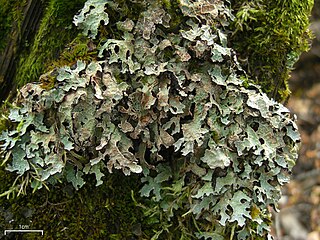
Acarospora is a genus of lichenized fungi in the family Acarosporaceae. Most species in the genus are crustose lichens that grow on rocks in open and arid places all over the world. They may look like a cobblestone road or cracked up old paint, and are commonly called cobblestone lichens or cracked lichens,. They usually grow on rock, but some grow on soil (terricolous) or on other lichens. Some species in the genus are fungi that live as parasites on other lichens. Acarospora is a widely distributed genus, with about 128 species according to a 2008 estimate.
Acarospora janae is a species of lichen in the Acarosporaceae family. Described as new to science in 2011, it is known only from New Mexico and Colorado in the United States, where it grows on siliceous rock.
Acarospora flavisparsa is a species of lichen in the family Acarosporaceae. Found in Portugal and Spain, it was described as new to science in 2011. The lichen grows on acidic rock walls in inland areas.

Crustose lichens are lichens that form a crust which strongly adheres to the substrate, making separation from the substrate impossible without destruction. The basic structure of crustose lichens consists of a cortex layer, an algal layer, and a medulla. The upper cortex layer is differentiated and is usually pigmented. The algal layer lies beneath the cortex. The medulla fastens the lichen to the substrate and is made up of fungal hyphae. The surface of crustose lichens is characterized by branching cracks that periodically close in response to climatic variations such as alternate wetting and drying regimes.

Lichen morphology includes lichen growth forms used to group lichens by "vegetative" thallus types, and forms of "non-vegetative" reproductive parts. Some lichen thalli have the aspect of leaves ; others cover the substrate like a crust, others such as the genus Ramalina adopt shrubby forms, and there are gelatinous lichens such as the genus Collema.

Lecanora muralis(Protoparmeliopsis muralis) is a waxy looking, pale yellowish green crustose lichen that usually grows in rosettes radiating from a center (placodioid) filled with disc-like yellowish-tan fruiting bodies (apothecia). It grows all over the world. It is extremely variable in its characteristics as a single taxon, and may represent a complex of species. The fruiting body parts have rims of tissue similar to that of the main nonfruiting body (thallus), which is called being lecanorine. It is paler and greener than L. mellea, and more yellow than L. sierrae. In California, it may be the most common member of the Lecanora genus found growing on rocks (saxicolous).
Punctelia colombiana is a species of corticolous (bark-dwelling) and foliose (leafy) lichen in the family Parmeliaceae. It is found in South America.

Punctelia graminicola is a species of foliose (leafy) lichen in the family Parmeliaceae. It grows on rocks, and, less frequently, on bark in North America, South America, and East Africa. It has a blue-grey thallus measuring up to about 15 cm (6 in), covered with tiny pores called pseudocyphellae. Sometimes the lichen forms small lobes that project out from the surface. Fruiting bodies are uncommon in this species; if present, they resemble small cups with a brown internal disc measuring 3–10 mm (0.1–0.4 in) in diameter. A lookalike species, Punctelia hypoleucites, is not readily distinguishable from Punctelia graminicola by appearance or habitat alone; these species can only be reliably differentiated by examining the length of their conidia.
Fuscidea muskeg is a species of crustose lichen in the family Fuscideaceae. Found in Alaska, it was described as a new species in 2020 by Tor Tønsberg and Martina Zahradníková. The type species was collected in the Hoonah-Angoon Census Area of Glacier Bay National Park. Here it was found growing on a branch of the tree Pinus contorta in muskeg. The specific epithet muskeg is an Algonquin word for a blanket bog.

Parmelia barrenoae is a species of foliose lichen in the large family Parmeliaceae. It was formally described as a new species in 2005. Before this, it was lumped together as one of several lichens in the Parmelia sulcata group—a species complex of genetically distinct lookalikes. Parmelia barrenoae is widely distributed, occurring in Europe, western North America, Africa, and Asia.
Astrothelium sipmanii is a species of corticolous (bark-dwelling) lichen in the family Trypetheliaceae. It is found in Guyana.

Silobia rufescens is a lichenized fungus, with a dark gray or brown crust-like appearance. It is widespread, and grows on siliceous rock. S. rufescens is in the genus Silobia, which is segregated from the genus Acarospora due to its budding apothecia with only lateral exciple.
Waynea cretica is a species of corticolous (bark-dwelling), squamulose lichen in the family Ramalinaceae. It occurs on the Greek island of Crete and in Portugal.
Buellia epifimbriata is a species of lichenicolous (lichen-eating) crustose lichen in the family Caliciaceae. It is only known to occur on Antiparos and Kos, two Greek islands in the southern Aegean Sea.
Variospora aegaea is a species of saxicolous (rock-dwelling), crustose lichen in the family Teloschistaceae. First identified from Greek islands in the Aegean Sea, and has since been recorded in Italy and Spain.
Lecanora panticapaensis is a species of saxicolous (rock-dwelling), crustose lichen in the family Lecanoraceae. It occurs in a single locality in Dnipropetrovsk Oblast, Ukraine, where it grows on the vertical surfaces of black schist beside a river.
Lecania sessilisoraliata is a species of saxicolous (rock-dwelling), crustose lichen in the family Ramalinaceae. It is found on rock outcrops in the mountainous Burdur region of Turkey.
Pertusaria pseudoparotica is a species of saxicolous (rock-dwelling), crustose lichen in the family Pertusariaceae. It is known from a few localities in Greece's Aegean Islands.
Verrucaria oulankaensis is a rare species of saxicolous (rock-dwelling) crustose lichen in the family Verrucariaceae. It is found in north-eastern Finland, where it occurs on calcareous rocks on river shores.
Verrucaria ahtii is a species of saxicolous (rock-dwelling) crustose lichen in the family Verrucariaceae. It is found in Finland, Lithuania, Russia, and Switzerland, where it occurs on calcareous pebbles.






